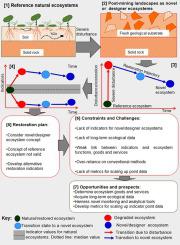Geoderma ( IF 5.6 ) Pub Date : 2021-01-25 , DOI: 10.1016/j.geoderma.2021.114944 Willis Gwenzi

|
Degraded post-mining landscapes exhibit unique biotic and abiotic components and processes relative to pre-disturbance natural ecosystems. Yet the concept of pre-disturbance reference natural ecosystems and their associated soil quality indicators (SQIs) (e.g., pH, soil organic carbon) are prominently used for assessing restoration of post-mining landscapes. Limited reviews exist on the validity, limitations, opportunities and knowledge gaps associated with the application of the concept and SQIs on post-mining landscapes. Hence, evidence was examined to highlight constraints, opportunities and future research directions pertaining to the concept and SQIs. First, as novel, hybrid or designer ecosystems, severely degraded post-mining landscapes lack reference natural ecosystems. The framing of restoration is multi-dimensional, and dependent on spatial and temporal scales. Therefore, short-term data on SQIs often measured at point scale cannot adequately account for the multi-dimensionality and scales. Moreover, evidence linking SQIs to ecosystem functions, goods, values, services, and benefits on degraded post-mining landscapes remains weak. Potential redundancy exists among SQIs, because soil properties exhibit spatial and temporal correlation. The universality of SQIs remains unconfirmed, because data validating the measurement protocols and interpretation of SQIs across various biomes are scarce. A framework is presented proposing: (1) a shift from the concept of reference natural ecosystems to novel and designer ecosystems in restoration ecology, (2) the development of the next generation of hierarchical or ecosystem cascade indicators, and end-points addressing the multi-dimensionality and scale issues, and (3) a decision matrix for integrating novel, hybrid and designer ecosystems. The potential applications of novel tools such as drones, laser-based cameras, genomics, and big data analytics are highlighted. Such novel tools could unravel the complex linkages among biotic and abiotic components, and ecosystem function and services, which are currently difficult to investigate using conventional techniques. Finally, ten tentative hypotheses are presented on the restoration of degraded post-mining landscapes.
中文翻译:

根据新的生态系统重新思考采矿后景观的恢复指标和终点
相对于扰动前的自然生态系统,退化的采后景观表现出独特的生物和非生物成分和过程。然而,扰动前参考自然生态系统的概念及其相关的土壤质量指标(SQI)(例如pH值,土壤有机碳)主要用于评估采矿后景观的恢复。关于在采矿后景观中应用概念和SQI的有效性,局限性,机会和知识差距的评论很少。因此,检查了证据以突显与概念和SQI有关的限制,机遇和未来的研究方向。首先,由于是新型,混合型或设计师型生态系统,严重退化的采后景观缺乏参考自然生态系统。恢复的框架是多维的,并取决于时空尺度。因此,通常以点尺度测量的SQI的短期数据不能充分考虑多维和尺度。此外,将SQI与生态系统功能,商品,价值,服务以及退化后的采矿景观的收益相关联的证据仍然薄弱。由于土壤特性表现出时空相关性,因此在SQI之间存在潜在的冗余。SQI的普遍性尚未得到证实,因为缺乏用于验证各种生物群落的测量协议和SQI解释的数据。提出了一个框架,该框架建议:(1)从参考自然生态系统的概念转变为恢复生态学中的新型生态系统和设计者生态系统;(2)开发下一代分级或生态系统级联指标,以及解决多维和规模问题的端点,以及(3)整合新颖,混合和设计师生态系统的决策矩阵。强调了诸如无人机,基于激光的照相机,基因组学和大数据分析等新型工具的潜在应用。这种新颖的工具可以揭示生物和非生物成分之间以及生态系统功能和服务之间的复杂联系,而这些联系目前很难使用传统技术进行研究。最后,提出了关于退化的采后景观恢复的十个假设。这种新颖的工具可以揭示生物和非生物成分之间以及生态系统功能和服务之间的复杂联系,而这些联系目前很难使用传统技术进行研究。最后,提出了关于退化的采后景观恢复的十个假设。这种新颖的工具可以揭示生物和非生物成分之间以及生态系统功能和服务之间的复杂联系,而这些联系目前很难使用传统技术进行研究。最后,提出了关于退化的采后景观恢复的十个假设。











































 京公网安备 11010802027423号
京公网安备 11010802027423号